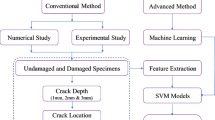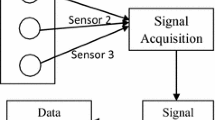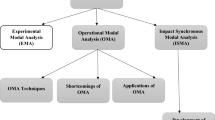Abstract
Many rotating machinery components fail due to fatigue when subjected to continuous fluctuating stresses. Hence, estimation of fatigue crack initiation life is essential to avoid catastrophic failure. Effective vibration based fatigue life analysis requires measurement of accurate time varying signal. In this study, experimentally observed fatigue lives of rotating shaft, for three different notch configurations, are compared with fatigue lives estimated using two approaches based on an acquired vibration signal. The first one is time domain approach (based on Rainflow cycle counting) while the second one is frequency domain approach (based on power spectral density moments). In the frequency domain approach, fatigue life is estimated using the narrow-band approximation and Dirlik’s empirical solution. The performance of two approaches in estimating fatigue life for the same signal length taken at different time intervals from the total signal acquired is also discussed. In addition, experimental uncertainty analysis is performed and discussed in this study. A good correlation is found between the estimated fatigue life using Dirlik’s rainflow range probability density function and experimental life. Therefore, this study concludes that the Dirlik’s approach can be considered as preferable method for estimating fatigue life of rotating shaft.
Similar content being viewed by others
References
A. Fatemi, Z. Zeng and A. Plaseied, Fatigue behavior and life predictions of notched specimens made of QT and forged microalloyed steels, International Journal of Fatigue, 26 (6) (2004) 663–72.
N. Daemi and G. H. Majzoob, Experimental and Theoretical investigation on notched specimen’s life under bending loading, World Academy of Science, Engineering and Technology, 5 (2011).
Q. Bader and E. Kadum, Effect of V notch shape on fatigue life in steel beam made of AISI 1037, International Journal of Engineering Research and Applications, 4 (6) (2014) 39–46.
M. Matsuishi and T. Endo, Fatigue of metals subjected to varying stress, Japan Society of Mechanical Engineers, Fukuoka, Japan, 68 (2) (1968) 37–40.
J. S. Bendat, Probability functions for random responses: prediction for peaks, fatigue damage, and catastrophic failures, National Aeronautics and Space Administration, Contract Report, 33 (1964).
C. Amzallag, J. P. Gerey, J. L. Robert and J. Bahuaud, Standardization of the rainflow counting method for fatigue analysis, International Journal of Fatigue, 16 (4) (1994) 287–293.
L. R. Gopi Reddy, L. M. Tolbert, B. Ozpineci and J. O Pinto, Rainflow algorithm-based lifetime estimation of power semiconductors in utility applications, IEEE Transactions on Industry Applications, 51 (4) (2015) 3368–3375.
A. Fatemi and L. Yang, Cumulative fatigue damage and life prediction theories: A survey of the state of the art for homogeneous materials, International Journal of Fatigue, 20 (1) (1998) 9–34.
A. Halfpenny, A frequency domain approach for fatigue life estimation from finite element analysis, Key Engineering Materials, Trans Tech Publications, 167 (1999) 401–410.
J. P Quigley, Y. L. Lee and L. Wang, Review and assessment of frequency-based fatigue damage models, SAE International Journal of Materials and Manufacturing, 9 (2016-01-0369) (2016) 565–577.
N. W. M. Bishop and F. Sherratt, Fatigue life prediction from power spectral density data. II: Recent developments, Environmental Engineering, 2 (2) (1989).
T. Dirlik, Application of computers in fatigue analysis, Ph.D. Thesis, University of Warwick (1985).
S. Ariduru, Fatigue life calculation by rainflow cycle counting method, MSME Thesis, Middle East Technical University, Ankara, Turkey (2004).
M. Yoon, K. Kim, J. E. Oh, S. B. Lee, K. Boo and H. Kim, The prediction of dynamic fatigue life of multi-axial loaded system, Journal of Mechanical Science and Technology, 29 (1) (2015) 79–83.
J. S. Rao, Optimized life using frequency and time domain approaches, IIUTAM Symposium on Emerging Trends in Rotor Dynamics, Springer, Dordrecht (2011) 13–26.
Regan and L. Manuel, Comparing estimates of wind turbine fatigue loads using time-domain and spectral methods, Wind Engineering, 3 (2) (2007) 83–99.
R. Tiwari and N. S. Vyas, Stiffness estimation from random response in multi-mass rotor bearing systems, Probabilistic Engineering Mechanics, 13 (4) (1998) 255–268.
H. Anzai and T. Endo, On-site indication of fatigue damage under complex loading, International Journal of Fatigue, 1 (1) (1979) 49–57.
S. D. Downing and D. F. Socie, Simple rainflow counting algorithms, International Journal of Fatigue, 4 (1) (1982) 31–40.
N. W. M. Bishop, Vibration fatigue analysis in the finite element environment, Anales de Mecanica de la Fractura, 16 (1999).
N. A. Noda and Y. Takas, Stress concentration formulae useful for any shape of notch in a round test specimen under tension and under bending, Fatigue and Fracture of Engineering Materials and Structures, 22 (12) (1999) 1071–1082.
B. Boardman, Fatigue resistance of steels, ASM International, Metals Handbook, 10 (1) (1990) 673–688.
ASTM E, Rainflow counting method, 1049–85.2005 (1987).
N. W. W. Bishop, The use of frequency domain parameters to predict structural fatigue, Doctoral Dissertation, University of Warwick (1988).
J. S. Bendat and A. G. Piersol, Book reviews: Engineering applications of correlation and spectral analysis, John Wiley and sons, New York, 13 (11) (1981) 25–26.
Author information
Authors and Affiliations
Corresponding author
Additional information
Recommended by Associate Editor Jun-Sik Kim
A. Seshadri Sekhar received his Ph.D. degree from IIT Madras, India, in 1993. He is currently a Professor in the Department of Mechanical Engineering at IIT Madras. His areas of research interests are rotor dynamics, tribology, condition monitoring and vibrations. He has over 175 publications in international journals and conferences.
Sagi Rathna Prasad is currently a Ph.D. student in Department of Mechanical Engineering, IIT Madras. His research interests are in the areas of vibration based fault diagnosis and prognosis in rotating machines. His works focus on the diagnosis of fault location identification, quantification and fatigue life estimation of rotors.
Rights and permissions
About this article
Cite this article
Prasad, S.R., Sekhar, A.S. Life estimation of shafts using vibration based fatigue analysis. J Mech Sci Technol 32, 4071–4078 (2018). https://doi.org/10.1007/s12206-018-0806-4
Received:
Revised:
Accepted:
Published:
Issue Date:
DOI: https://doi.org/10.1007/s12206-018-0806-4




